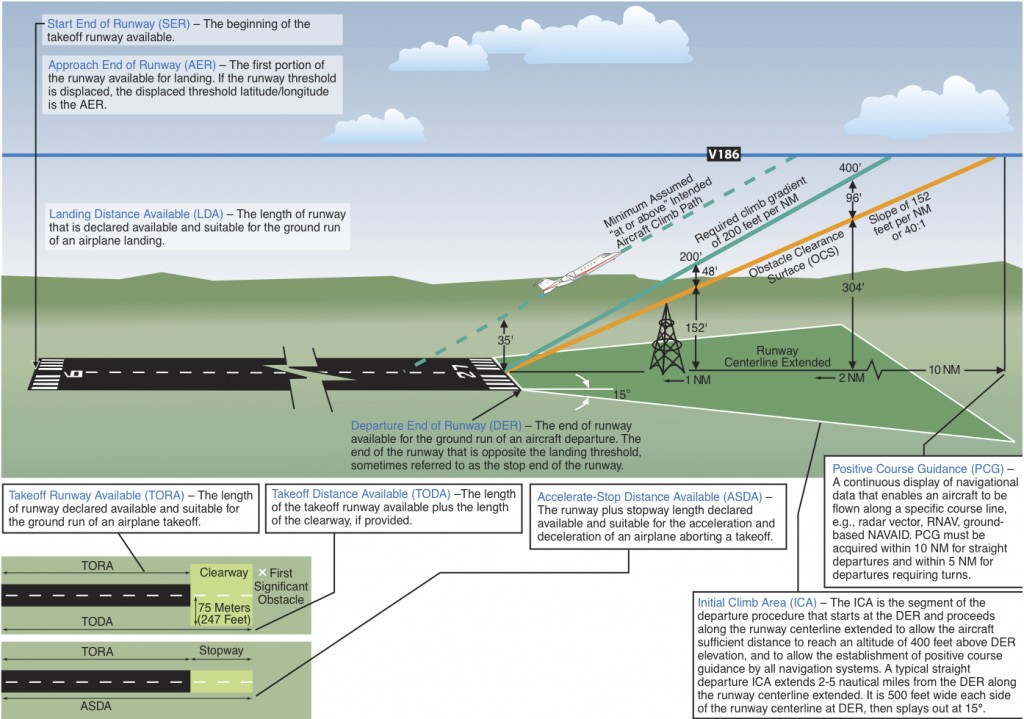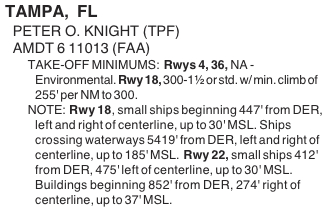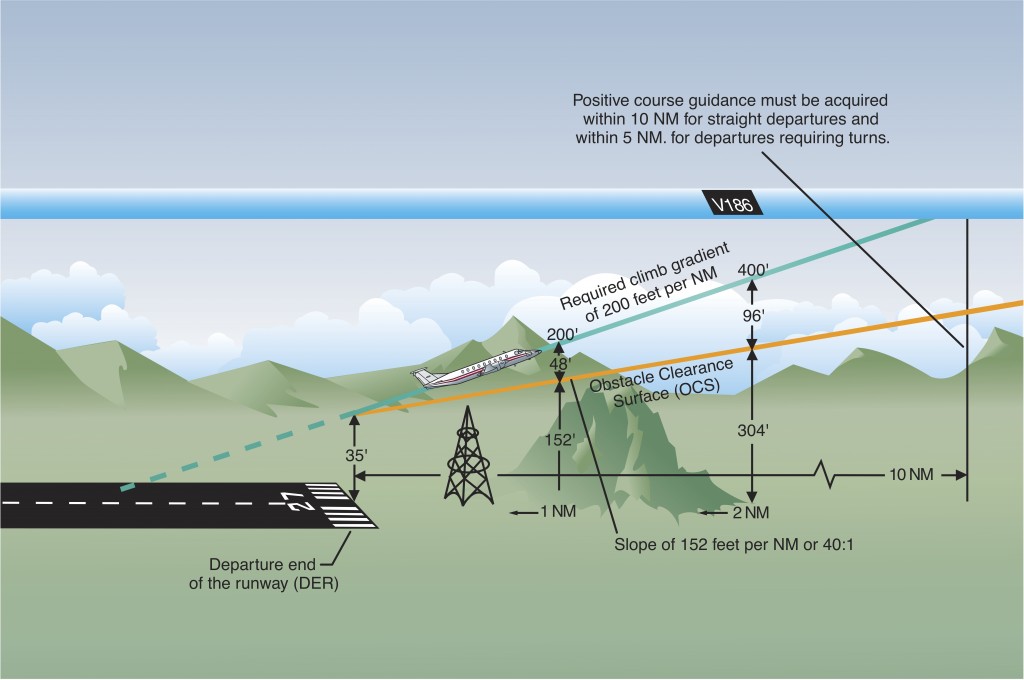LaGuardia Airport in New York City is one of the more challenging airports due to limited airport surface for taxiing and many obstacles in the departure path. I recently had a conversation with a First Officer at a regional airline who said LaGuardia is rewarding to fly into but you must be vigilant.
During our conversation he related that some Captains he flies with are not aware of the climb gradients or how to calculate the rate of climb. In defense of Captains, maybe because I am one, charts are normally provided describing the maximum weights for the runway and weather conditions. But since he brought it up let’s review departure procedures and climb gradients.
Instrument Departure Procedures
Instrument departure procedures are preplanned Instrument Flight Rules (IFR) procedures which provide obstruction clearance from the terminal to the appropriate enroute structure. There are two types of Departure Procedures (DP), Obstacle Departure Procedures (ODP), and Standard Instrument Departures (SID).
The primary purpose of departure procedures is to provide obstacle clearance. The second purpose is to increase efficiency at busier airports by reducing the number of communications and departure delays through the use of preplanned departure procedures or SIDs.
Departure Design Criteria
While designing approach procedures at airports the FAA also researches obstacle clearance during departure and climb from the airport. Two standards currently exist for designing departure procedures with the old design pictured at the beginning of this article and the new more restrictive criteria pictured below.

(click image to enlarge)
You will not know which design criteria is used but in both cases obstacle clearance is based on the assumption that the aircraft will cross the departure end of the runway at 35 feet, make no turns until 400 feet above the departure end of the runway, and climb at 200 feet per nautical mile. When obstacles penetrate the Obstacle Clearance Surface (OCS) a higher climb gradient is required. Think of the obstacle clearance surface as the ground since this is the slope where the top of obstructions may be present.
In designated non-mountainous areas the climb gradient will typically give you one thousand feet of obstacle clearance at 25 nautical miles from the departure end of the runway. In mountainous areas the obstacle clearance of two thousand feet will typically be obtained at 46 nautical miles from the departure end of the runway.
Both the old and new departure criteria will normally allow for Positive Course Guidance(PCG) within 10NM (Nautical Miles) for straight out departures and within 5NM for those departures requiring a turn. Both criteria have a Required Obstacle Clearance (ROC) which is the distance between the required climb gradient and the Obstacle Clearance Surface (OCS).
Calculating Rate Of Climb Required
Most commercial operators which include airlines have done the calculations for each runway and have printed takeoff data to determine compliance with any runway or obstacle departure procedures. For some runways with many obstacles in the climb path, special departure procedures and climb gradients have been established. Some procedures include climb gradients to avoid adjacent airspace.
The process of determining compliance with a required climb is a simple matter of looking at a chart for the maximum takeoff weight for a specific aircraft configuration, temperature, and atmospheric pressure. The aircraft configuration options normally include anti ice on or off, a flap setting, and a power setting.
As general aviation pilots we must do the analysis on our own by referencing the Aircraft Flight Manual (AFM) to determine the rate of climb and ground speed for the current conditions. After obtaining the aircraft’s rate of climb and ground speed from the AFM we can calculate the required minimum rate of climb for the departure. To make our calculations easier there is a rate of climb table in the terminal procedures publication. The table normally begins with the standard climb gradient of 200 feet per nautical mile. Cross reference your ground speed and the required climb gradient and you will get the minimum required rate of climb.

(click image to enlarge)
If a climb gradient table is not available, the rate of climb can be calculated manually. Take your ground speed in nautical miles per hour, divide by 60 minutes per hour, and multiply by the climb gradient in feet per nautical mile. The result will be the required rate of climb in feet per minute.
Example:
If a climb gradient of 200 ft per nautical mile is required and our ground speed in the climb is 90 knots we will need a rate of climb of 300 feet per minute.
90 Nautical Miles Per Hour divided by 60 minutes per hour = 1.5 nautical miles per minute. 1.5 nautical miles per minute times 200 feet per nautical mile = 300 feet per minute.
Example:

Departing Peter O. Knight Airport runway 18. Non-standard takeoff minimums apply due to obstacles. Let's assume the weather is 200 foot ceiling and one mile visibility. Since we cannot climb in visual conditions and the ceiling is less than 300 feet we will need to climb at 255 feet per nautical mile.
After reviewing the aircraft flight manual we determine our rate of climb for today’s conditions is 850 feet per minute. Next we determine our ground speed is 70 knots. Referencing the climb gradient table we will need to interpolate. Notice the largest number we must interpolate between is 400 feet per minute. This is well under our ability to climb at 850 feet per minute and therefore we can safely depart.
If we wanted to calculate a more exact figure, we could take the 255 feet per nautical mile and our ground speed of 70 knots and plug it into our formula:
(70 KTS divided by 60 minutes) times 255 feet per nautical mile = 298 feet per minute required rate of climb. Again well under our 850 feet per minute rate of climb.
Conclusion:
Determining the required rate of climb based on a climb gradient is simple but you must know where to look for the information. You may either look in your Aircraft
Flight Manual or performance charts provided by the commercial operator. It is always important to determine if you can climb above all obstacles in your departure path, especially if you are climbing in Instrument Meteorological Conditions (IMC) or at night.
Safe Flying!


Comments on this entry are closed.
Thanks for the good explanation. I still wonder if this required rate of climb is AEO or with a critical engine inop? In other words, should the pilot use his e.g. single engine (OEI) climb performance (which should then be better than e.g. 255’/min above?)
Please clarify. Much appreciated!
JB
JB, have a look at http://www.nbaa.org/ops/safety/climb-performance/20120510-one-engine-inoperative-climb-performance-planning.php:
“An engine failure during takeoff is a non-normal condition, and therefore takes precedence over noise abatement, air traffic, SIDs, ODPs, and other normal operating considerations. This correctly implies that you are not required to maintain the SID or ODP profile, either laterally or vertically.”
Hello Captain,
Thank you very much for the explanation.
My question is if ATC requested A/C to climb to flight altitude 20000ft QNH in 50 NM with a given speed of 300 kts, what will be the rate of climb?
Is it simply only by dividing alt. over distance or do i have to get the time?
Thank you in advance.
As per table 6.1 of jeppesen, for CAT I approach, reported visibility may be converted into RVR. Now clarification is required, should this conversion formula be applied on any reported visibility which is less than 800m or on the reported visibility which is equal to or more than 800m. My understanding to the table is that if charted value for approach is RVR600m and reported visibility is 350m at night , and lighting system of the R/W permits to multiply by 2, now figure comes out 700m, which is more than charted value but less than 800m then approach is not allowed but if reported visibility is 400m, then after conversion, figure is 800m, which is equal to the value of 800m, then approach may be carried out. Pl clarify my understanding. Thanks
…
It would still be a good idea to calculate the engine out number as well though it’s not required. Remember they’re trying to keep you from hitting an obstacle not give you more chores. Of course on a nice VFR day you probably won’t need to calculate it.
Wonderful beat ! I would like to apprentice while you amend your
site, how can i subscribe for a weblog site? The account aided me a applicable deal.
I were a little bit familiar of this your broadcast provided
bright clear idea